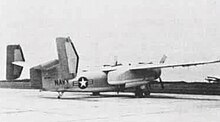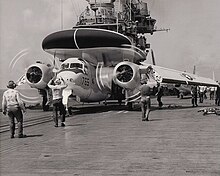m
Reverted edits by
198.207.222.130 (
talk) to last version by 75.202.119.67 |
|||
| Line 27: | Line 27: | ||
The E-1 was designated '''WF''' under the old US Navy system; the designation earned it the nickname "Willy Fudd". Since the S-2 Tracker was known as S2F under the old system, that airplane was nicknamed "Stoof"; the WF/E-1 with its distinctive [[radome]] gained the nickname "Stoof with a Roof."<ref name="Proceedings">O'Rourke, G.G., CAPT USN. "Of Hosenoses, Stoofs, and Lefthanded Spads". ''United States Naval Institute Proceedings'', July 1968.</ref> |
The E-1 was designated '''WF''' under the old US Navy system; the designation earned it the nickname "Willy Fudd". Since the S-2 Tracker was known as S2F under the old system, that airplane was nicknamed "Stoof"; the WF/E-1 with its distinctive [[radome]] gained the nickname "Stoof with a Roof."<ref name="Proceedings">O'Rourke, G.G., CAPT USN. "Of Hosenoses, Stoofs, and Lefthanded Spads". ''United States Naval Institute Proceedings'', July 1968.</ref> |
||
iurygvablfuigretiwqnhlfdjhasiterfbgvnbjfyerw |
|||
===Radar=== |
|||
tyik |
|||
The Tracer was fitted with the [[Hazeltine Corporation|Hazeltine]] AN/APS-82 in its radome. The radar featured an Airborne Moving Target Indicator (AMTI), which analyzes the [[Doppler effect|Doppler shift]] in [[Reflection (physics)|reflected]] [[radar]] energy to distinguish a flying aircraft against the clutter produced by wave action at the ocean's surface. Separating a moving object from stationary background is accomplished by suitable hardware. |
|||
==Variants== |
==Variants== |
||
Revision as of 19:16, 27 September 2009
| E-1 Tracer | |
|---|---|

| |
| E-1B Tracer | |
| Role | Carrier AEW |
| Manufacturer | Grumman |
| First flight | 17 December 1956 |
| Introduction | 1958 |
| Retired | 1977 |
| Status | Retired |
| Primary user | United States Navy |
| Number built | 88 |
| Developed from | C-1 Trader |
The E-1 Tracer was the first purpose built airborne early warning aircraft used by the United States Navy. It was a derivative of the C-1 Trader and first entered service in 1958. It was replaced by the more modern E-2 Hawkeye in the early 1970s.
Design and development
The E-1 was designated WF under the old US Navy system; the designation earned it the nickname "Willy Fudd". Since the S-2 Tracker was known as S2F under the old system, that airplane was nicknamed "Stoof"; the WF/E-1 with its distinctive radome gained the nickname "Stoof with a Roof." [1]
iurygvablfuigretiwqnhlfdjhasiterfbgvnbjfyerw tyik
Variants


- XTF-1W/XWF-1
- aerodynamic prototype (BuNo 136792) without electronics, later rebuilt as a standard C-1A, retaining the twin tail.
- WF-2
- Airborne Early Warning version of the TF-1 Trader, redesignated E-1B in 1962, 88 built.
- E-1B
- WF-2 redesignated in 1962.
Operators
Specifications


|
|
This aircraft article is missing some (or all) of its specifications. If you have a source, you can help Wikipedia by adding them. |
General characteristics
- Crew: 4, two pilots, two RADAR/Intercept Controllers
Performance
Armament
none
References
Notes
- ^ O'Rourke, G.G., CAPT USN. "Of Hosenoses, Stoofs, and Lefthanded Spads". United States Naval Institute Proceedings, July 1968.
Bibliography
- Winchester, Jim (ed.). "Grumman S-2E/F/G/UP Tracker." Modern Military Aircraft (Aviation Factfile). Rochester, Kent, UK: Grange Books plc, 2004. ISBN 1-84013-640-5.
Aircraft on Display
There is an E-1B Tracer on the flight deck of the USS Yorktown (CV-10) at Patriot's Point Naval and Maritime Museum in Mount Pleasant, SC.
See also
Related development
Aircraft of comparable role, configuration, and era
External links
m
Reverted edits by
198.207.222.130 (
talk) to last version by 75.202.119.67 |
|||
| Line 27: | Line 27: | ||
The E-1 was designated '''WF''' under the old US Navy system; the designation earned it the nickname "Willy Fudd". Since the S-2 Tracker was known as S2F under the old system, that airplane was nicknamed "Stoof"; the WF/E-1 with its distinctive [[radome]] gained the nickname "Stoof with a Roof."<ref name="Proceedings">O'Rourke, G.G., CAPT USN. "Of Hosenoses, Stoofs, and Lefthanded Spads". ''United States Naval Institute Proceedings'', July 1968.</ref> |
The E-1 was designated '''WF''' under the old US Navy system; the designation earned it the nickname "Willy Fudd". Since the S-2 Tracker was known as S2F under the old system, that airplane was nicknamed "Stoof"; the WF/E-1 with its distinctive [[radome]] gained the nickname "Stoof with a Roof."<ref name="Proceedings">O'Rourke, G.G., CAPT USN. "Of Hosenoses, Stoofs, and Lefthanded Spads". ''United States Naval Institute Proceedings'', July 1968.</ref> |
||
iurygvablfuigretiwqnhlfdjhasiterfbgvnbjfyerw |
|||
===Radar=== |
|||
tyik |
|||
The Tracer was fitted with the [[Hazeltine Corporation|Hazeltine]] AN/APS-82 in its radome. The radar featured an Airborne Moving Target Indicator (AMTI), which analyzes the [[Doppler effect|Doppler shift]] in [[Reflection (physics)|reflected]] [[radar]] energy to distinguish a flying aircraft against the clutter produced by wave action at the ocean's surface. Separating a moving object from stationary background is accomplished by suitable hardware. |
|||
==Variants== |
==Variants== |
||
Revision as of 19:16, 27 September 2009
| E-1 Tracer | |
|---|---|

| |
| E-1B Tracer | |
| Role | Carrier AEW |
| Manufacturer | Grumman |
| First flight | 17 December 1956 |
| Introduction | 1958 |
| Retired | 1977 |
| Status | Retired |
| Primary user | United States Navy |
| Number built | 88 |
| Developed from | C-1 Trader |
The E-1 Tracer was the first purpose built airborne early warning aircraft used by the United States Navy. It was a derivative of the C-1 Trader and first entered service in 1958. It was replaced by the more modern E-2 Hawkeye in the early 1970s.
Design and development
The E-1 was designated WF under the old US Navy system; the designation earned it the nickname "Willy Fudd". Since the S-2 Tracker was known as S2F under the old system, that airplane was nicknamed "Stoof"; the WF/E-1 with its distinctive radome gained the nickname "Stoof with a Roof." [1]
iurygvablfuigretiwqnhlfdjhasiterfbgvnbjfyerw tyik
Variants


- XTF-1W/XWF-1
- aerodynamic prototype (BuNo 136792) without electronics, later rebuilt as a standard C-1A, retaining the twin tail.
- WF-2
- Airborne Early Warning version of the TF-1 Trader, redesignated E-1B in 1962, 88 built.
- E-1B
- WF-2 redesignated in 1962.
Operators
Specifications


|
|
This aircraft article is missing some (or all) of its specifications. If you have a source, you can help Wikipedia by adding them. |
General characteristics
- Crew: 4, two pilots, two RADAR/Intercept Controllers
Performance
Armament
none
References
Notes
- ^ O'Rourke, G.G., CAPT USN. "Of Hosenoses, Stoofs, and Lefthanded Spads". United States Naval Institute Proceedings, July 1968.
Bibliography
- Winchester, Jim (ed.). "Grumman S-2E/F/G/UP Tracker." Modern Military Aircraft (Aviation Factfile). Rochester, Kent, UK: Grange Books plc, 2004. ISBN 1-84013-640-5.
Aircraft on Display
There is an E-1B Tracer on the flight deck of the USS Yorktown (CV-10) at Patriot's Point Naval and Maritime Museum in Mount Pleasant, SC.
See also
Related development
Aircraft of comparable role, configuration, and era